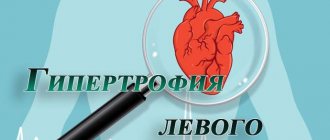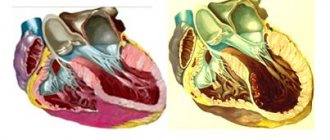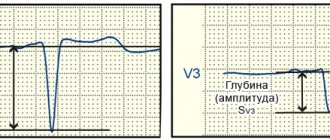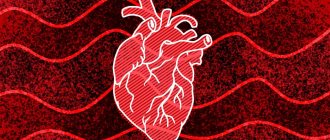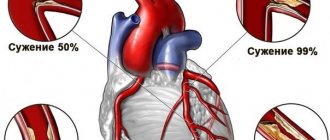Left ventricular hypertrophy is a common complication of hypertension, dangerous because it develops over years and does not show any symptoms for a long time. Over time, the disease progresses, leading to hardening of the walls of the left ventricle and loss of tissue elasticity. Since the disease is quite serious and dangerous, competent and timely treatment is required. Therefore, it is very important to know how hypertrophy of the left ventricle of the heart manifests itself, treatment of which with folk remedies and medications can eliminate the symptoms of the disease.
Myocardial hypertrophy of the left ventricle of the heart - what is it?
Myocardial muscle cells perform the function of contraction and relaxation, depending on the phase of the heart (systole or diastole, respectively). Hypertrophy develops as a result of overload of the heart muscle. It can be caused by a large volume of blood entering the ventricle and then the influence of high pressure due to strong stretching of the muscle.
If this happens regularly, then the muscle cells change their structure - they become thicker and more elongated, this happens in order to provide sufficient contraction force and throw all the blood from the ventricle into the aorta.
Structural changes in cells affect the thickness of the interventricular septum, it becomes wider, and the myocardial mass increases. Enlarged muscle cells need more oxygen, but since the coronary arteries cannot supply more arterial blood, hypoxia develops - oxygen starvation.
Danger of disease
The left ventricle in a healthy body is one of the main connecting links in the human circulatory system, allowing blood to move through the arteries to the aorta. Next, the blood penetrates into organs and tissues through blood vessels.
However, with hypertrophy, the muscle tissue of the interventricular septum grows, which greatly narrows the lumen of the left ventricle. As a result, not only blood circulation is disrupted, but also other metabolic processes of the body. This occurs due to the fact that little oxygen and microelements reach the organs and tissues.
Types of hypertrophy
Depending on the cause of hypertrophy, it can be eccentric or concentric.
The first type develops due to the entry of a large amount of blood into the ventricle, followed by strong stretching of its walls. This may be a consequence of obesity or insufficiency of the heart valves (aortic and mitral).
Next, there are two options:
- The walls of the ventricle thicken and the cavity expands. In this case, the work of the heart is not significantly impaired, since the volume of blood entering the aorta does not change.
- Maintaining the size of the ventricular walls, but at the same time increasing the mass of the myocardium. This occurs due to the flow of blood into the ventricle in large quantities, it becomes like a filled balloon. But despite this, a much smaller volume of blood is released into the aorta.
Hypertrophy is also distinguished:
- With obstruction of the outflow tract - in this case, the muscle walls thicken inside the ventricle and occupy most of its cavity. As a result, subaortic stenosis may develop, and blood flow is significantly impaired.
- Without obstruction - may be in the case of diffuse hypertrophy, which is of a concentric type.
- Asymmetric – thickening is localized in the area of the muscular septum. With such hypertrophy, both the presence and absence of obstruction are possible.
Depending on the wall thickness increased during hypertrophy, there are three stages:
- up to 21 mm;
- 21-25 mm;
- over 25 mm.
The disease contributes to disruption of the functioning of the heart muscle, the duration of the systole and diastole phases changes, and insufficient oxygen saturation of the organs appears. That is why coronary heart disease, heart failure, stroke and heart attack are dangerous consequences that hypertrophy of the left ventricle of the heart can cause. Treatment with folk remedies should not be done on your own, otherwise taking the wrong medications can aggravate the problem.
Stages of hypertrophy
Cardiac hypertrophy goes through three stages:
- Initial – with a slight increase in muscle mass.
- Compensation stage - full blood circulation in the body is maintained due to the thickened heart wall, but its existing vascular network is no longer sufficient, and the first symptoms of oxygen deficiency occur.
- Stage of decompensation - impaired blood supply to the heart muscle leads to cell atrophy; muscle fibers are replaced by fatty or scar tissue that is not capable of rhythmic contraction; Blood stagnates in the heart chamber and heart failure develops.
Causes of the disease
Thickening of the muscle walls and septum is a consequence of overexertion. It occurs when a large volume of blood enters the ventricle and needs to be pushed out into the aorta. The pressure on the walls and their stretching are above normal. Because of this, hypertrophy of the left ventricle of the heart develops. The reasons may be different. But mainly these are certain diseases:
- The most common cause is arterial hypertension. High pressure causes constant antispasmodic manifestations in the vessels and high resistance in them.
- Acquired or congenital heart defects - valve insufficiency, aortic stenosis, narrowing of a certain area of the aorta (coarctation).
- The presence of calcium deposits on the walls of the aorta or heart valves or atherosclerosis of the aorta.
- Hyperthyroidism (disorders of the endocrine system, in particular overworking of the thyroid gland), diabetes mellitus, diseases of the adrenal glands.
Age and gender characteristics, as well as proper nutrition, have a great influence.
Causes of hypertrophy
Psycho-emotional overload, violation of the daily routine, unfavorable working conditions, excessive sports activities, bad habits - have become dangerous factors that have caused widespread, accompanied by an increase in the mass of the left myocardium.
Thickening of the left ventricular muscles in 90% of cases is caused by hypertension, especially if it is combined with atherosclerosis. Hypertension is a consequence of chronic stress and metabolic disorders; With age, more and more people are susceptible to it.
https://www.youtube.com/watch?v=6UqtT_s6_FM{amp}amp;list=PL2SJgIGOT_MLdt0X73O83s_XJhnLI2POu
WHO sets the limits of normal blood pressure within 140/90 mm Hg. Art. With an increase in the tone of the vascular walls and a narrowing of the lumen of the arteries, the heart needs to exert more effort to fully pump blood through the vascular bed, and the heart muscle increases in mass. With each subsequent stage of hypertension, the mass of the heart muscle increases noticeably.
Cardiac hypertrophy occurs and is aggravated by valve defects that block the path to reverse blood flow:
- from the ventricle to the atrium;
- from the aorta to the ventricle.
When the valve flaps do not close tightly, the efficiency of the heart muscle decreases, and the internal organs experience hypoxia (lack of oxygen). The heart, in compensation, increases the force of contraction due to the increased mass of the left ventricular muscle.
Cardiomyopathy
The heart muscle can change volume due to. As a result of hereditary conditions, some muscle fibers are depleted, then to maintain a normal level of blood flow, other fibers increase muscle mass.
In this case, not only the walls of the heart grow, but also the septum between its chambers, which leads to a decrease in the working volume of the ventricles. This means that the heart has to thicken the myocardium even more to fill the vascular bed with blood. When the muscle thickens, it loses its elasticity and pain occurs.
Obesity
Metabolic disorders due to dietary sins are increasingly spreading among the population of civilized countries. Promotes obesity and a decrease in physical activity, a decrease in the proportion of intense physical labor.
- body weight increases, an increase in the vascular network is required;
- diabetes mellitus gradually develops, changing metabolism;
- vascular tone increases.
Physical exercise
The need for oxygen and nutrients increases among people engaged in heavy physical labor and professional athletes. The left ventricle of the heart gradually grows, hypertrophy becomes pronounced.
The risk group includes people who, in order to lose weight, at their own peril and risk, determine the level of physical activity in the gym. The result of excessive efforts is left ventricular hypertrophy with all its undesirable consequences.
Bad habits
Smoking and alcoholism negatively affect the tone of blood vessels, affecting their walls. The higher the smoking experience and the degree of alcoholism, the greater the risk a person exposes himself to.
Alcoholic cardiomyopathy develops especially quickly with frequent consumption of beer - an enlarged “beer heart” becomes a cause of death within three years.
Abuse of caffeine-containing drinks and energy drinks leads to an increase in tissue demand for oxygen with excessive mobilization of the heart muscle and its hypertrophy.
This serious disease affects not only older people, but also young people. It is necessary to undergo regular medical examinations in order to recognize the disease in time and prevent its development, which can lead to myocardial infarction.
Treatment for cardiac muscle hypertrophy is prescribed by a cardiologist. Herbal medicines prepared at home can be used as aids. They cleanse the blood, strengthen the walls of blood vessels and have a calming effect.
Doctors believe that left ventricular hypertrophy in most cases develops against the background of other diseases of the cardiovascular system:
- vices;
- aortic stenosis;
- atherosclerosis of the aorta.
The most common cause is high blood pressure. It leads to overstrain of the heart muscle, which is forced to contract more often and stronger.
You should be wary if:
- haunted by constant fatigue;
- shortness of breath appears with slight physical exertion;
- arms and legs swell;
- dizzy;
- pressure constantly increases;
- pain and heaviness occur in the heart area.
When such symptoms bother you, you need to contact a cardiologist and change your life. It is important to give up excessive physical activity, bad habits, follow a special diet and maintain heart function with folk remedies.
Initially, it must be said that left ventricular hypertrophy is not a disease, but only one of the symptoms indicating serious malfunctions in the functioning of the heart and blood vessels. There are quite a few reasons for this condition, so we list the most likely ones:
- cardiovascular diseases (hypertension, as well as atrial fibrillation or aortic valve stenosis);
- other serious diseases (pulmonary edema or kidney pathologies);
- psychological instability and constant stress;
- physical inactivity (sedentary lifestyle);
- strenuous sports training;
- hereditary predisposition;
- long absence of rest;
- muscular dystrophy;
- alcohol and smoking;
- diabetes;
- Fabry disease;
- atherosclerosis;
- obesity.
All the reasons that lead to such a pathological condition as hypertrophy of the left ventricle of the heart are divided into:
- physiological;
- pathological.
Physiological reasons include active training and lifestyle. Moreover, they must be commensurate with the abilities of the patient’s body. The thing is that the entire load on the left cardiac ventricle is directly proportional to physical activity.
Among the pathological causes of hypertrophy, hereditary and acquired are distinguished. Congenital cardiac pathologies make up only a small percentage of all types of hypertrophies. The most common congenital pathologies are heart defects, which are expressed in a violation of the outflow of blood from the cardiac ventricle.
The causes of hypertrophy of the left ventricle of the heart can be varied, including both chronic and acquired diseases of different parts of the body:
- hypertension;
- obesity: the development of the disease is very dangerous in young children who are overweight;
- ischemia;
- diabetes;
- arrhythmia, atherosclerosis;
- frequent excessive physical activity;
- alcoholism, smoking;
- high blood pressure;
- lung diseases;
- aortic stenosis;
- disturbances in the functioning of the mitral valve;
- stress, psychological illness, nervous exhaustion.
The development of the body in a child can occur with disruption of the processes of myocardial repolarization and, as a result, an increase in the walls of the ventricle. If such a situation arises, it must be prevented, and then monitored on a regular basis throughout adulthood and prevent progression.
Constant exercise can naturally lead to heart enlargement, while work associated with heavy lifting is a potential threat of systolic overload, so you should normalize your physical activity and monitor your health.
Another indirect cause is sleep disturbance, in which a person stops breathing for a short period of time. It can be observed in women during menopause or in older people and entails consequences such as expansion of the diameter of the heart vessels, growth of the septum and walls of the heart, increased blood pressure, and arrhythmia.
Hypertrophy (myocardium) of the left ventricle of the heart is a pathological growth of the heart wall - a muscle called the myocardium.
The myocardium is a thick layer of muscle that literally “pumps” blood throughout the organs and tissues of the human body.
Typically, at an early stage of development, left ventricular hypertrophy does not manifest itself in any way. A person can live peacefully for quite a long time without even realizing that there is something wrong with his heart. And only over time can pathology make itself felt.
The particular danger of this disease is that it is a kind of harbinger of even more serious heart problems. People with hypertension, congenital heart defects, aortic valve stenosis, mitral regurgitation, and other cardiovascular problems are predisposed to left ventricular hypertrophy.
Increased physical activity, when the heart is forced to work for a long time at an increased rate, can also provoke the occurrence of this disease.
So-called sleep apnea can also lead to left ventricular hypertrophy. With this disorder, during a night's rest, a person's respiratory function stops for a few seconds, i.e. he simply stops breathing.
This pathology can appear due to factors that cause the left ventricle to contract more intensely, and the muscle wall grows because of this. These may be certain diseases or excessive stress on the heart.
Hypertrophy of the left ventricle of the heart often occurs in professional athletes who receive excessive aerobic exercise (aerobic - that is, “with oxygen”): these are track and field athletes, football players, and hockey players. Due to the increased operating mode, the muscular wall of the left ventricle is “pumped up”.
The disease can also occur due to excess weight. Large body weight creates additional stress on the heart, which forces the muscle to work more intensely.
But here are the diseases that provoke thickening of the wall of this chamber of the heart:
- chronic hypertension (pressure above 145 per 100 mm Hg);
- narrowing of the aortic valve;
- atherosclerosis of the aorta.
The disease can also be congenital. If the wall is not very thick (the value does not exceed 18 mm), no treatment is required.
Myocardial hypertrophy of the left ventricle of the heart - what is it? The left ventricle of the heart is necessary for the movement of arterial blood coming from the left atrium. From the ventricle, oxygenated blood is sent to the aorta (through the aortic valve) and then through the blood vessels (arteries) to each individual organ.
Symptoms of the disease
Hypertrophy of the left ventricle of the heart, the symptoms of which do not have a clear clinical picture, may not be felt for several years. But, despite this, there are a number of responses of the body, in the presence of which it is necessary to pay attention to the state of your health:
- high blood pressure, which is difficult to correct even with the use of medications;
- sudden onset of shortness of breath during normal activities;
- weakness, fatigue;
- heart rhythm disturbances;
- increased swelling;
- dizziness;
- pain in the heart area.
Often people, having discovered some symptoms of the disease, treat their hearts with folk remedies. However, the best solution would be to visit a qualified cardiologist who will make the correct diagnosis and prescribe the appropriate treatment.
Hypertrophy as an age-related change
As mentioned earlier, an increase in the size of the ventricle occurs in response to hypertension, when there is chronically high blood pressure.
In most cases, this pathology occurs in the middle-aged and elderly population suffering from physical inactivity.
Such patients may be overweight and have bad habits such as smoking and drinking alcohol.
Enlargement of the left ventricular muscle occurs when the flow of blood into the systemic circulation is obstructed. The heart muscle adapts to new conditions by thickening the walls of the ventricle .
Treatment of the disease
Since hypertrophy develops as a result of the progression of various diseases, when treating it, it is necessary to initially eliminate the original pathology. How to treat left ventricular hypertrophy of the heart should be explained by the doctor after carrying out the necessary diagnostics.
You should not take medications without medical advice, even if they are aimed at treating your disease. Since without taking into account the personal characteristics of the body and the tolerance of certain components of the drug, one can only aggravate the course of the disease.
Treatment with St. John's wort
St. John's wort herb (100 g), pour water (2 l) and boil for ten minutes, after which it needs to be cooled, strained and added a spoonful of honey. You need to take a third of a glass half an hour before meals.
This method, according to patients, is most effective when hypertrophy of the left ventricle of the heart is detected. Treatment with folk remedies in some cases can have a great impact on the general condition of the patient.
Treatment of hypertrophy with lily of the valley
Lily of the valley drops are often used in the practice of eliminating heart diseases. Left ventricular hypertrophy is no exception. Treatment with folk remedies in any case must be approved by the attending physician.
The recipe consists of preparing a tincture. Lily of the valley flowers are placed in a bottle (the bottle is completely filled with flowers), filled with alcohol (to the top) and infused for two weeks. Take a tablespoon before meals (3 times a day).
Left ventricular hypertrophy on ecg. Tests and diagnostics
At the initial visit to the doctor, complaints are collected and anamnesis is described. An objective examination includes listening to heart sounds, percussion and palpation. These methods allow you to determine the boundaries of the heart and identify its expansion. When listening to tones, the rhythm and their intensity (intensification/muffling) are assessed. Instrumental diagnostic methods are required. Indirect signs can be seen from the results of electrocardiography.
ECG. Signs of left ventricular hypertrophy on the ECG, signs of damage to other parts of the heart:
- the electrical axis is deflected to the left or located horizontally; in the V and VI chest leads, the R wave is enlarged;
- the P wave on the ECG is deformed due to changes in the atria; the “P-pulmonale” shape corresponds to the right atrium, and the “P-mitrale” shape corresponds to the left atrium;
- right ventricular hypertrophy is characterized by deviation of the electrical axis to the right, in leads V1 and V2 there is an increase in the R wave; changes in the electrical conductivity of the heart are recorded.
EchoCG. Allows you to determine the size of the heart cavities, thickening of the myocardium, calculate the pressure gradient, and calculate the mass of the myocardium during hypertrophy. Based on the results of echocardiography, it is possible to assess the pumping function of the heart and the condition of the valve apparatus.
R-graphy of the chest organs. The shape of the heart shadow is assessed; most often, the film clearly shows a hypertrophied, stretched left ventricle in the form of a characteristic protrusion at the apex.
Treatment with garlic
Chopped garlic is mixed with honey (in equal proportions in any suitable container) and left for a week (you need to shake the container periodically). This recipe helps well with such a diagnosis as left ventricular hypertrophy of the heart. Treatment with folk remedies in this version can be used year-round. You need to take one teaspoon of the medicine daily.
Treatment of the heart with folk remedies in many cases has a positive effect on health. But before taking any medications or herbs, you should consult your doctor.
Load on the left ventricle
A person has a four-chambered heart. With rhythmic contractions, the heart pumps blood simultaneously through two vascular systems - the systemic and pulmonary circulation. The right side of the heart sends blood to the lungs to enrich it with oxygen.
Both lungs are at the same level as the heart, so the load on the right myocardium is small and no great effort is required. The left ventricle, by contracting its muscles, creates an impulse that should ensure blood flow in the most remote parts of the body and lift blood through the carotid arteries up to the brain. Therefore, on the left side the heart wall is thicker.
The heart of other mammals (with a horizontal body position and support on four limbs) does not perform such a difficult function. A person with his vertical axis of the body freed his hands for work, but added load to the left ventricle of the heart.
Herbal treatment
Herbal remedies are often used in the treatment of LVH. One of the most popular consists of hawthorn flowers, knotweed grass and horsetail. For 300 ml of water, take one spoon of the mixture and prepare an infusion. Take in small portions throughout the day, dividing the entire volume into 5-6 times.
Another option is a collection based on motherwort, wild rosemary and dried wild rosemary. Take the herbs in equal parts, chop and mix. Prepare a strong decoction. Take half a glass 4 times a day, taking the medicine with cranberries grated with sugar.
Prevention
The main preventive actions to prevent the occurrence of left ventricular hypertrophy include:
- Lifestyle changes:
- to give up smoking;
- alcohol abuse;
- following a diet that includes cholesterol limited to 300 mg per day and minimal fat intake;
- moderately active lifestyle.
- Combating risk factors:
- bringing body weight to normal levels;
- normalization of blood pressure.
- Control of hypertension and hyperlipidemia with medications is necessary if lifestyle correction does not bring results:
- maintaining normal sugar levels;
- control of other risk factors for diabetes;
- reducing the tendency to the formation of blood clots;
- Women of childbearing potential are advised to avoid taking oral contraceptives.
Compliance with all preventive measures in combination will avoid the occurrence of left ventricular hypertrophy. It will also improve overall well-being and improve the quality of life.
Cardiologist, Functional diagnostics doctor
For many years, Dr. Zhuravlev has been helping patients with cardiopathology get rid of problems in the functioning of the heart and blood vessels, so the specialist provides comprehensive therapy for hypertension, ischemia, and arrhythmia.
The healing properties of lily of the valley were experienced by a woman suffering from left ventricular hypertrophy. Healing drops from lily of the valley quickly helped restore the functioning of the heart muscle.
Recipe for lily of the valley drops: pour the flowers into a bottle with a narrow neck, add alcohol or moonshine, leave for two weeks in a dark place. After infusion, pour into another vessel and drink 15 drops 3-4 times a day. The course of treatment is 2 months.
Recipe for lily of the valley gruel: taking the tincture at the same time, you can enhance the effect of the healing process and take lily of the valley gruel. To prepare it, 1 tbsp. a spoonful of flowers is poured with boiling water, left for 1 hour, after which the liquid is drained (you can also drink it) and the softened raw material is taken in the form of a paste, two spoons every three hours during the day.
Healing the heart with wine
This excellent remedy should be taken by those who have ventricular myocardial hypertrophy caused by heart defects. If you carry out four such treatment courses within a year, you can forget about many symptoms.
Recipe No. 1: 100 g of dry leaves, pour 2 liters of dry red wine, leave for 1 month in a cool, dark place. Sometimes you need to shake the mixture. Strain and squeeze. It is recommended to take 50 ml 3-4 times a day for 1.5 months.
Recipe No. 2: 10 g of fresh stems without leaves, pour 1 liter of dry red or white natural wine, add 2 tbsp. spoons of wine vinegar. Boil over low heat for 10 minutes. Then add 300 g of honey and cook for another 4-5 minutes. Without cooling, pour into bottles, seal, and store in a cool place. Take 1 tbsp. spoon 4-5 times a day.
Treatment of ventricular myocardium with garlic
The remedy can be taken all year round, taking short breaks. Grind the garlic to a pulp, add honey and place in a dark place for a week, shaking the container with this mixture from time to time. Take 1 tbsp. spoon three times a day half an hour before meals. honey and garlic are taken in equal proportions.
Treatment of ventricular myocardial hypertrophy with St. John's wort
Pour 100 g of dry crushed herb into 2 liters of water, boil over low heat in a sealed container for 10 minutes. Leave for 1 hour, strain, add 200 g of honey. Stir thoroughly and pour into bottles. Take 1/3 cup 3 times a day, half an hour before meals, store in the refrigerator.
The human heart is a complex mechanism; the ventricular myocardium does not always withstand stress. When the heart does not bother us, we do not take care of it - we abuse alcohol, smoke, overload it with work after heavy meals. We must remember that the heart needs to be helped, not harmed. It is advisable to reduce weight by eating in moderation, using fractional meals. The diet may contain lean meats, seafood, dairy and fermented milk products.
Physical culture and sports have been and will always be necessary for our body.
The heart and its peripheral assistants need to be trained and strengthened. Every day of every child and adult should begin with physical exercise. When starting treatment, first of all, it is necessary to normalize the level and follow a diet. It is recommended to eat less fatty and salty foods and lead an active lifestyle.
Left ventricular hypertrophy (cardiomyopathy) is a common pathology in hypertensive patients. The risk of mortality with this diagnosis is quite high: 1 in 25 people with cardiomyopathy die during severe stress on the body.
Hypertrophy refers to uneven thickening of the wall of the left cardiac ventricle, resulting from loss of elasticity of the heart muscle. Left ventricular hypertrophy often occurs with hypertension, heart defects, and in people experiencing frequent intense exercise.
Dangerous factors are alcoholism, smoking, obesity, physical inactivity and the introduction of unusually large loads on the body. If severe pain in the heart occurs, you should contact a cardiologist who will conduct an examination and prescribe appropriate treatment. Therapy can be supplemented independently, and folk remedies will help with this.
Treatment with folk remedies
Before using the methods described below, you should consult your doctor!
Herbal treatment
Treatment with berries
- Grind freshly picked cranberries with a spoon or grind through a meat grinder, combine with powdered sugar in a ratio of 3:1. Eat with tea, 2-3 spoons per day. Cranberries will perfectly strengthen the cardiovascular system and increase the overall immunity of the body.
- Strawberry jam has a beneficial effect on the general condition of the body and is indicated for diseases of the cardiovascular system. Boil fresh strawberries, peeled from stems and leaves, with sugar (for 1 kg of strawberries take 0.1 - 0.2 kg of granulated sugar) for half an hour over low heat, stirring continuously and not allowing the mixture to burn. Eat the resulting jam with tea in reasonable quantities. Cannot be preserved; store in the refrigerator.
Other methods
- Pour cow's milk into a heat-resistant container and simmer in a preheated oven until a golden crust forms on the surface of the liquid. Drink 1 glass a day before bedtime.
- Wine with rosemary. Pour 0.1 kg of dry leaves and stems of rosemary into 2 liters of young dry wine from red grape varieties. Leave in the refrigerator for 20 - 30 days, then strain and consume 50 ml before each meal (no more than 200 ml per day).
- Wine with parsley and wine vinegar. In 1 liter of dry wine, add 10 g of chopped cuttings of freshly picked parsley and 15 ml of ordinary wine vinegar. Bring the wine to a boil over low heat, gradually adding bee honey (0.3 kg). Pour the hot mixture into jars and store in the cold. Take 1 – 2 spoons several times a day.
- Mince the garlic twice and mix half and half with bee honey. Transfer the resulting mixture into glass and store for a week in the refrigerator or on the balcony. Eat 2 spoons a day before your main meal (more is possible).
Left ventricular hypertrophy is a compensatory increase in the volume of muscle mass of the left cardiac ventricle following an increase in the load on it. This is not an independent disease, but one of the symptoms of several pathologies, mainly associated with disturbances in the structure and tone of the vascular walls.
Normally, the thickness of the myocardium (cardiac muscles) of the left ventricle is 10-12 mm, its wall is always twice as thick as the muscles of the right ventricle. Hypertrophy is said to exist if the thickness of the myocardium exceeds these figures.
It is a signal of serious disorders in the cardiovascular system - no longer in the initial, but in the developed stages. The danger of this phenomenon lies in the fact that after the compensatory increase in the muscle, its depletion occurs over time, leading to sad results.
Treatment
Most often, left ventricular hypertrophy is not an independent disease, but a symptom of one or another pathology, mainly of the cardiovascular system. Therefore, before starting treatment, it is necessary to establish the cause of the pathology and take the necessary measures to treat the underlying disease.
For example, one of the causes of left ventricular hypertrophy is congenital heart disease. In this case, surgical treatment is indicated, after which symptomatic therapy is prescribed. In addition, pathogenetic treatment is prescribed, which is aimed at slowing down the processes of hypertrophy.
First of all, when starting treatment, you must try to eliminate the cause of hypertrophy. Without this, treatment may not have the desired effect. For example, if hypertrophy arose due to a sedentary lifestyle, various bad habits, irrational and unhealthy nutrition, it is useless to take any steps without normalizing the lifestyle. It is better for such patients to use moderate physical activity, doing aerobics, running, swimming.
The diet of patients with hypertrophy must contain foods that are rich in vitamins, coenzyme Q-10, microelements (potassium, calcium, magnesium), and omega fatty acids. The presence of such substances helps strengthen the myocardial wall and has a positive effect on metabolic processes in tissues.
Drug treatment for left ventricular hypertrophy is not always used. First of all, it is aimed at restoring myocardial nutrition and heart rhythm. These are beta-blockers (, etc.) and antiarrhythmic drugs (,). Taking medications that regulate cardiac activity is necessary throughout the patient’s life. They should never be combined with alcohol. In addition, the use of angiotensin inhibitors, antihypertensive drugs (, and others) is indicated. It is advisable to get rid of bad habits. For example, nicotine reduces oxygen saturation of the heart muscle.
For patients with left ventricular hypertrophy, fractional nutrition is indicated. It is necessary to drink a sufficient amount of liquid, be sure to monitor regular bowel movements (at least 1-2 times a day), since it is responsible for the absorption of all nutrients in the body. Hypertrophy can be triggered by increased blood sugar, so to treat this condition it is necessary to take medications that normalize sugar.
If the measures taken do not allow stopping the hypertrophy process, in some cases surgical intervention is recommended, which consists of removing a section of hypertrophied muscle. The operation is indicated for congenital heart defects in childhood.
Surgical intervention for left ventricular hypertrophy consists of two types of operations. The first is to eliminate ischemia and is performed at the stage of decompensation of the pathological process. This can be achieved using coronary artery stenting and angioplasty. Another type of surgery is the correction of heart defects. For this purpose, valve replacement and commissurotomy are performed if their function is insufficient.
Left ventricular hypertrophy is a dangerous pathology. If it is present in the body, the percentage of various complications increases. Therefore, you should always monitor your blood pressure level, regularly see a cardiologist and undergo ultrasound and electrocardiographic examination of the heart in order to be able to track the dynamics of this situation. If all recommendations are followed correctly, the outcome of the disease is favorable.
Treatment options
Many people, accustomed to using folk methods to treat everything possible, wonder whether it is possible to cure ventricular hypertrophy with the same folk remedies.
Everything described above clearly shows how serious this disease is, not at all a joke. No herbs, lotions or tinctures can help here.
You should not risk your health - as soon as you feel arrhythmia, weakness and pain in the heart area, it is better to immediately consult a doctor. He will prescribe proper treatment.
The only folk remedy that can help with this disease is changing your lifestyle.
The patient needs to quit smoking as soon as possible, switch to a salt-free and low-calorie diet, be sure to lose weight and gradually accustom your body to light physical activity.
The healthier lifestyle he follows, the better his prognosis. But if the drug treatment process does not bear the expected fruits, it is possible that surgery may be required.
What it is?
Hypertrophy implies thickening of the walls of the left ventricle and this does not occur due to the characteristics of the internal space. The septum between the ventricles changes, and tissue elasticity is lost.
The thickening is not necessarily uniform, but can occur only in some areas of localization.
Hypertrophy itself is not a diagnosis, but is one of the symptoms of any disease of the cardiovascular system. This is mainly hypertension. In addition, we can distinguish various types of heart defects, frequent and heavy loads on the heart muscle.
In order for the heart muscle to begin to increase in size, the following conditions are necessary:
- A large load, which leads to expansion of the internal cavity of the heart. At the same time, during systole, the myocardium begins to contract more strongly.
- Pressure load on the heart, which is characterized by the fact that in order to expel blood, muscle contraction must occur much more often and stronger.
Both of these provoking factors will contribute to the thickening of contractile fibers - myofibrils of cardiomyocytes. At the same time, mechanisms for increasing connective tissue are launched. The heart needs to increase its ability to expand more and more, so collagen development will occur faster.
Therefore, it turns out that hypertrophy in almost all cases leads to disruption of the structure of the myocardium. The more intense the process of hypertrophy, the faster the ratio of collagen and myocytes decreases.
The most dangerous situation is intense and sudden physical activity. This applies to people who smoke, abuse alcohol, or sedentary individuals whose physical activity increases sharply. If a modification of the left ventricle did not lead to death, this does not mean that it is safe for health. It can lead to quite serious disorders - it could be a myocardial infarction or stroke.
Left ventricular hypertrophy is a signal that indicates a worsening of the conditions in which the myocardium is located at that time. This is like a warning, indicating to a person the need to stabilize his blood pressure and correctly distribute the load.
